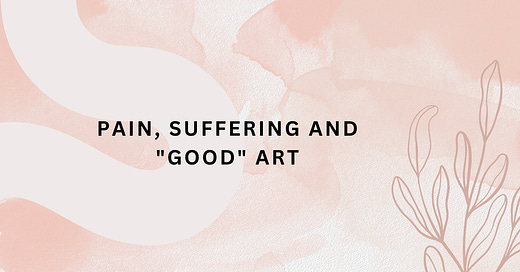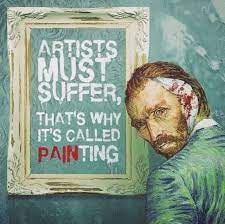PAIN, SUFFERING, AND "GOOD" ART
The tortured artist and “good” art (Trigger warning: There are discussions of suicide and mental illnesses, if that isn’t something for you then it’s fine to skip).
On the 22nd of June, 2023, Kim Namjoon of BTS shared a quote by Jean Holz which said “Calm is more conducive to creativity than is anxiety” and it got me thinking about the tortured artist trope and its effects on popular culture and zeitgeist.
Side note: I don’t guarantee that I won’t reference BTS in my essays, I can however guarantee that it would be worth it at the end of the day.
What is the tortured artist?
The tortured artist is the artist that is dealing with mental illness, pain, addiction, or something larger than him/her and then uses that frustration to make art, phenomenal art. ‘Artist’ here is used very loosely, the tortured artist could be a writer, musician, director, etc. The artist here is a stand-in for ‘creative’. What is generally thought of when the tortured artist is said is- a creative yet misunderstood genius who lives on the edge of the world. Traits of a tortured artist include things like untidiness, weird behaviours or eccentricism, and melancholy. The tortured artist then channels all these attributes towards making “introspective and good” art.
Think of Van Gogh who cut part of his ear and was institutionalized but he made art that was so good it has outlived him by centuries. We also have Sylvia Plath, the influential feminist poet who released her semi-autobiographical novel and then committed suicide a month after. We also have modern-ish tortured artists like Kurt Cobain who changed the rock scene with his band Nirvana but wrestled with addiction and what seems to me like “undiagnosed mental illness”. He ended up committing suicide. I could go on and on with many examples.
Basically, the tortured artist is what is described when Aristotle said “No great genius has ever existed without a strain of madness”.
The tortured artist is very popular in the cultural zeitgeist from movies to literature so I am sure you can think of a fictional character or real person who fits the definition of the tortured artist. I do have to ask what does the tortured artist do to how we view creativity and life? Because to me it holds you back from your happiness. The need for pain for artistic excellence is dangerous because it “fetishizes” mental illness and also illness in general. It encourages self-immolation on the altar of producing vital works.
When I speak of the “fetishization of mental illness”, I am not speaking of the anti-woke idea that everyone is faking mental illness for attention. I am referring to the flattening of mental illness, making it one-dimensional. Mental illness is a topic that already lacks nuance in popular discussion. Illnesses like bipolar disorder, schizophrenia, etc are not understood properly in “popular culture”. These illnesses are not only excluded from discussions of mental health, they are also excluded from popular understandings of the tortured artist. The tortured artist trope is one-dimensional in the sense that we have a cutesy picture. We have a picture of a mad genius working to create that top-tier work of art, book, or literature. In the process, we totally ignore what it is like to live with the complexities of mental illness and addiction.
Art can serve as some sort of “therapy” but there is nothing inherently beautiful about living in turmoil and chaos. We run the risk of creating an environment where people suffering don’t seek help because they are worried about still being able to create valuable art when they get well. They begin to think “Can I still create art that moves when I am unburdened from pain and suffering?”. Even we, the audience, begin to think “That is a part of his/her creative process” when the artist is having a crisis not “We need to get him/her help”.
The tortured artist trope promotes the notion that it isn’t skill or practice that makes a person a good artist but a touch of “fine madness”. It also creates a climate where “serious art” only comes from suffering. We then denigrate things that are popular, entertaining, or made for joy with joy.
This is not to say that mentally ill people, people dealing with addiction and suffering can not create good art. In fact, I don’t believe that mental illness or suffering of any kind takes away the ability to create good art. It may make the creative process complex but it doesn’t kill the ability to create good art. The truth is there is no right answer about if suffering/mental illness produces good art because correlation doesn’t translate to causation. The aim of this essay is to critique the tortured artist trope so we can leave what I think is an unsustainable way of making “good art” and move into creating good art while living full lives.
Thank you for reading. If you enjoyed reading, kindly share with other people and on social media platforms. See you next time I publish another essay.





This is a remarkable piece
Strongly agree. I think it also has to do with the fetishisation of mental illnesses, which hurts people who are experiencing these challenges. Painting mental illness as a 'superpower' ignores the real struggles that people face when they are mentally ill. People focus on just the 'artist' aspect of 'tortured artist'. It's as though, by default, we don't expect mentally ill people to be able to fit into society. And the eccentricities they inevitably display are woven into a form of pleasure for others. Society needs to improve in its understanding of mental health and its approach to mentally ill people in general. If anything, art should be a leveller, teaching us that anyone (regardless of their personal struggles) can create beauty.